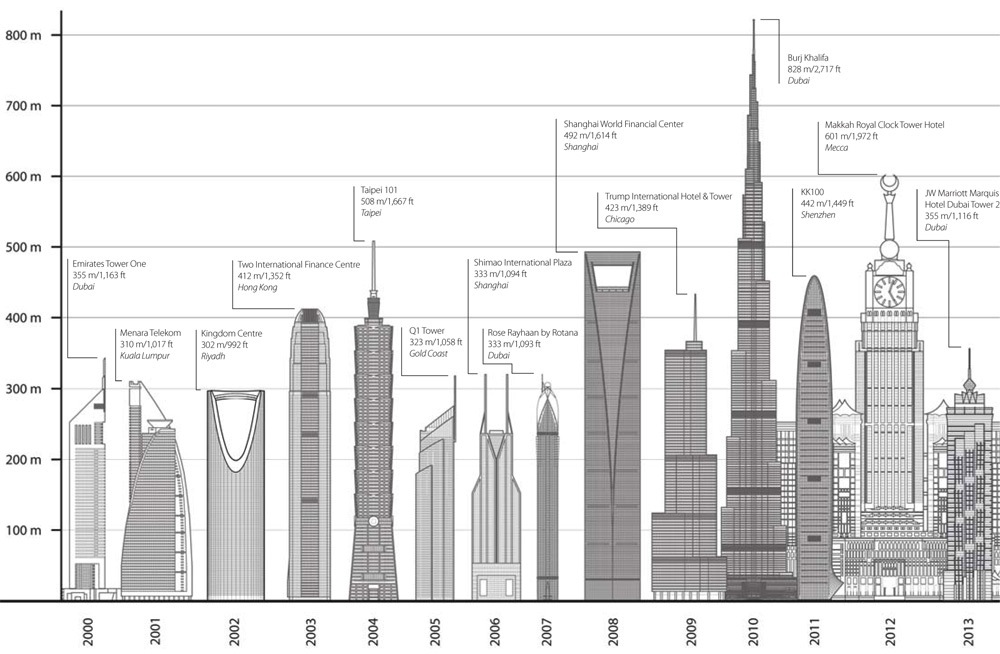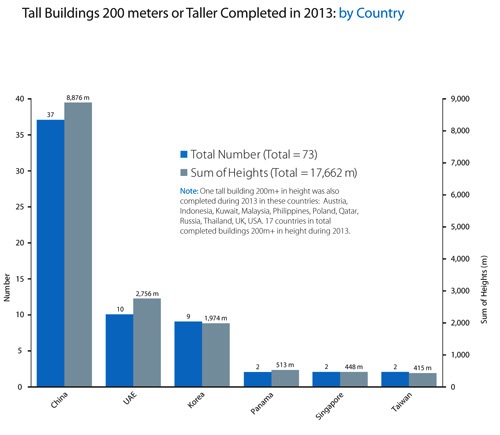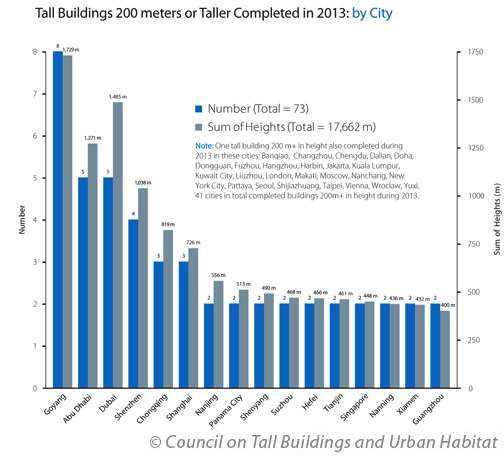While 2013 didn't see the completion of a mega tower like Burj Khalifa, it was a near-record-setting year in terms of the number of super-tall skyscrapers completed.
Led by the 82-story, 1,166-foot JW Marriott Marquis Hotel Dubai Tower 2, a total of 73 buildings of 200 meters or greater height were built in 2013. It was the second-busiest year ever, behind only 2011, when 81 super-tall projects opened, according to a report by the Council on Tall Buildings and Urban Habitat (CTBUH).
Last year also saw the completion of nine 300-meter-plus towers. In fact, nearly half (47%) the world's 77 300-meter-plus skyscrapers were completed during the past four years.
The top 10 skyscrapers completed in 2013 are:
1. JW Marriott Marquis Hotel Dubai Tower 2, Dubai, UAE (82 stories, 355 meters, 1,166 feet)
2. Mercury City Tower, Moscow, Russia (75, 339, 1,112)
3. Modern Media Center, Changzhou, China (57, 332, 1,089)
4. Al Yaqoub Tower, Dubai, UAE (69, 328, 1,076)
5. The Landmark, Abu Dhabi, UAE (72, 324, 1,063)
5. Deji Plaza, Nanjing, China (62, 324, 1,063)
7. Cayan Tower, Dubai, UAE (73, 307, 1,008)
8. East Pacific Center Tower A, Shenzhen, China (85, 306, 1,004)
8. The Shard, London, UK (73, 306, 1,004)
10. Dongguan TBA Tower Dongguan, China (68, 289, 948)
See the full list

Tall buildings 200 meters or taller completed each year from 1960 to 2014 © CTBUH (click image to enlarge)
Other milestones from 2013, according to the CTBUH report:
• Across the globe, the sum of heights of all 200-meter-plus buildings completed globally in 2013 was 17,662 meters – also the second-ranked in history, behind the 2011 record of 21,642 meters.
• Of the 73 buildings completed in 2013, 12 – or 16 percent – entered the list of 100 Tallest Buildings in the World.
• For the sixth year running, China had the most 200-meter-plus completions of any nation, at 37 – located across 22 cities.
• Three of the five tallest buildings completed are in the United Arab Emirates, for the second year in a row.
• The city of Goyang, Korea, has debuted on the world skyscraper stage with eight 200-meter-plus buildings completing in 2013.
• Europe has two of the 10 tallest buildings completed in a given year for the first time since 1953.
• Panama added two buildings over 200 meters, bringing the small Central American nation’s count up to 19. It had none as recently as 2008.
• Of the 73 buildings over 200 meters completed in 2013, only one, 1717 Broadway in New York, was in the U.S.
For the full report, visit: http://www.ctbuh.org/TallBuildings/HeightStatistics/AnnualBuildingReview/Trendsof2013/tabid/6105/language/en-US/Default.aspx

The tallest building completed each year since the year 2000. © CTBUH (click image to enlarge)

© CTBUH (click image to enlarge)

© CTBUH (click image to enlarge)
Related Stories
| Apr 5, 2011
Top 10 Buildings: Women in Architecture
Making selections of top buildings this week led to a surprising discovery about the representation of women in architecture, writes Tom Mallory, COO and co-founder, OpenBuildings.com. He discovered that finding female-created architecture, when excluding husband/wife teams, is extremely difficult and often the only work he came across was akin to interior design.
| Apr 5, 2011
What do Chengdu, Lagos, and Chicago have in common?
They’re all “world middleweight cities” that are likely to become regional megacities (10 million people) by 2025—along with Dongguan, Guangzhou, Hangzhou, Shenzhen, Tianjin, and Wuhan (China); Kinshasa (Democratic Republic of the Congo); Jakarta (Indonesia); Lahore (Pakistan); and Chennai (India), according to a new report from McKinsey Global Institute: “Urban World: Mapping the economic power of cities”.
| Mar 30, 2011
China's low-carbon future city
In 2005, the Chinese government announced its target to reduce energy consumption per GDP unit by 20% by the year 2010. After a multi-billion investment, that target has been reached. The Chinese Climate Protection Program’s goal to increase energy efficiency, develop renewable energies, and promote energy savings while reducing pollutant emissions and strengthening environmental protection is reflected in the “Future City” by SBA Design.
| Mar 30, 2011
Is the AEC industry at risk of losing its next generation leaders without better mentoring?
After two or three horrifying years for the AEC industry, we are finally seeing the makings of a turnaround. However, data developed by Kermit Baker as part of the AIA Work-on-the-Boards survey program indicates that between 17% and 22% of design firms are eliminating positions for interns and staff with less than six years of experience. This data suggests the industry is at risk of losing a large segment of its next generation of leaders if something isn't done to improve mentoring across the profession.
| Mar 29, 2011
City's design, transit system can ease gas costs
Some cities in the U.S. are better positioned to deal with rising gas prices than others because of their design and transit systems, according to CEOs for Cities, a Chicago-based nonprofit that works to build stronger cities. The key factor: whether residents have to drive everywhere, or have other options.
| Mar 29, 2011
Chicago’s Willis Tower to become a vertical solar farm
Chicago’s iconic Willis Tower (formerly the Sears Tower) is set to become a massive solar electric plant with the installation of a pilot solar electric glass project.
| Mar 29, 2011
Read up on Amazon.com's new green HQ
Phase IV of Amazon’s new headquarters in Seattle is nearly complete. The company has built 10 of the 11 buildings planned for its new campus in the South Lake Union neighborhood, and is on-track for a 2013 grand opening.
| Mar 29, 2011
Portuguese architect Eduardo Souto de Moura wins Pritzker Architecture Prize
Portugese architect Eduardo Souto de Moura, whose precisely-honed buildings reflect the influence of the late Chicago modernist Mies van der Rohe, is the 2011 winner of the Pritzker Architecture Prize, the field's highest honor.
| Mar 25, 2011
Qatar World Cup may feature carbon-fiber ‘clouds’
Engineers at Qatar University’s Department of Mechanical and Industrial Engineering are busy developing what they believe could act as artificial “clouds,” man-made saucer-type structures suspended over a given soccer stadium, working to shield tens of thousands of spectators from suffocating summer temperatures that regularly top 115 degrees Fahrenheit.












